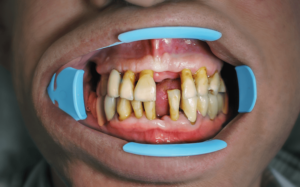It can be upsetting to look in the mirror and notice gaps between your teeth. Having gums that look uneven can also leave you concerned. Any of these irregularities could be due to an exposed tooth root, a problem that requires professional care. Learning about the causes of an exposed tooth root can help you detect it and get the best treatment if it occurs.
Why Does a Tooth Root Become Exposed?
A tooth is like an iceberg, most of which you do not see because it is underwater. With a tooth, the root is covered underneath the gum line and extends into the jawbone. The root makes up about two-thirds of the whole tooth and contains pulp, protective enamel, ligaments, nerves, and blood vessels.
Problems can occur with a tooth root poking through the gum and becoming exposed. There are several causes of an exposed tooth root, one of which is injury or trauma. This can happen if you suffer a blow to your mouth. The trauma can cause the tooth to break or move from its original position. A tooth that merely shifts in the gums can become visible. The trauma can also be caused by aggressive tooth brushing or a hard bristle toothbrush. Teeth grinding and clenching may also produce trauma contributing to recession and gum loss.

Gradual root exposure can also result from gum disease or more advanced periodontal disease. Untreated gum disease typically causes inflammation and usually leads to recession, when gums retreat or pull away and eventually expose tooth roots.
Some tooth root exposures are easy to see, mainly if they occur in the front of the mouth. Upon close inspection, you might be able to see an exposed root because of a broken tooth or damaged gums. There might also be a tooth that appears to be loosening or turning around.
If exposed roots are in the back of the mouth or crowded by other teeth, they can be hard to detect. You might have an exposed root if you experience any of these symptoms:
- Bleeding gums
- Broken tooth
- Fever with tooth pain
- Infection or abscess
- Pain while brushing or flossing
- Pain that does not subside with over-the-counter analgesics or medication
- Changes in the appearance of your teeth or gums
- Sensitivity to hot or cold foods or liquids
A tooth root contains nerves and tissues that can cause pain when exposed to air. In addition to exposed tooth root pain relief, professional treatment can usually fix the damage and ward off infection that might lead to more serious medical problems.
How to Fix an Exposed Tooth Root
Unless severe tooth decay has occurred, your dentist can recommend an exposed tooth root treatment to save your tooth and ease your pain. The treatment usually depends on the reason for the exposure.
If tooth decay is the cause, your dentist will usually remove the decayed material and replace it with a filling. In more extreme cases, you might need a root canal or tooth extraction to correct the problem. Emergency dental care for mouth injuries or trauma is required to fix the broken tooth or surrounding jaw.
For root exposure related to gum recession, the dentist can use scaling and root planing to clean the roots and this may aid in gum reattachment. Scaling involves removing plaque and tartar at or below the gums while root planing smooths the root’s surface to allow the gums to reattach.
Another solution to gum recession is gum grafting or a coronal repositioned flap procedure. These periodontal procedures are the most predictable way to restore the gumline and eliminate recession. However, the results may not last and additional periodontal surgery may be necessary to maintain the desired results.
Patients with exposed roots due to misalignment can get help from an orthodontist. Braces or Invisalign fixtures can correct the problem in most cases. More serious misalignments might require surgery.
Preventing Exposed Tooth Root
Tooth decay, gum recession, misalignment, and injury often cause tooth root exposure. Your dentist can address these causes before root exposure occurs and causes intense pain and other complications.
It is important to always use a soft bristle toothbrush and not brush too hard at the gumline. There is a happy medium… too light or too heavy of pressure can cause gum erosion and recession. If you are grinding or clenching your teeth, you should have a professional night guard fabricated and be sure to wear it every night. These night appliances require very meticulous adjustments that can only be performed by an experienced dentist. Over-the-counter night guards are not recommended to prevent recession caused by clenching and grinding or TMJ disorders.
An exposed root can be painful, disrupting your regular eating, sleeping, and talking. It is unwise to ignore an exposed tooth root or put off treating it until later. You might incur more damage without early intervention and need more intensive treatment later.
Regular professional cleanings by a dental hygienist and good oral hygiene at home are more straightforward ways to prevent tooth root exposure. If you notice an exposed root, it is important to seek dental care as soon as possible, even if you do not experience pain or other symptoms.
- Dental Implant Pros and Cons - August 26, 2023
- Receding Gums Stages - August 12, 2023
- When Is It Too Late for Gum Grafting? - July 8, 2023


